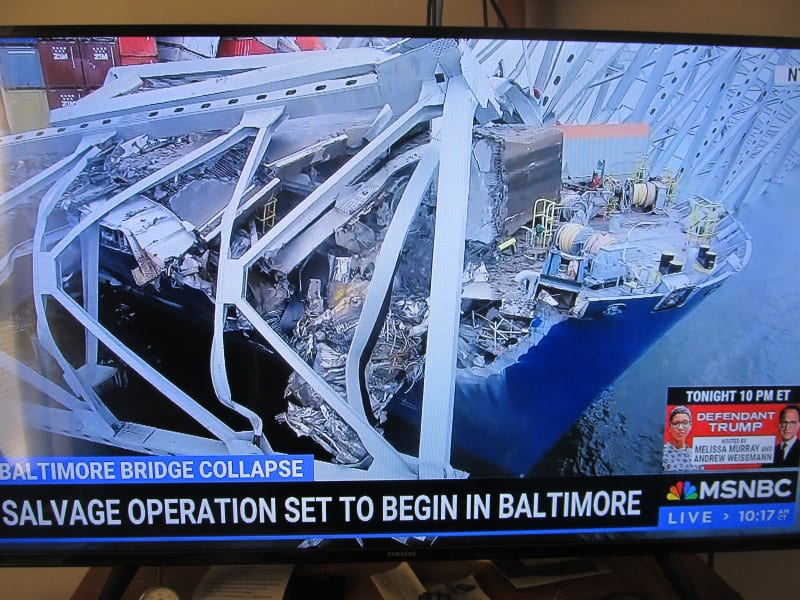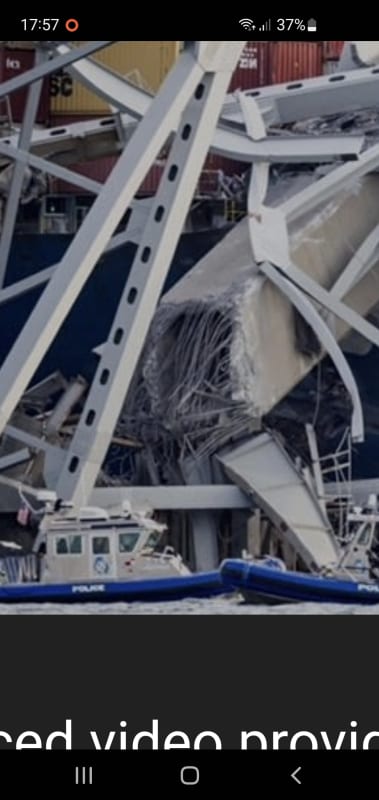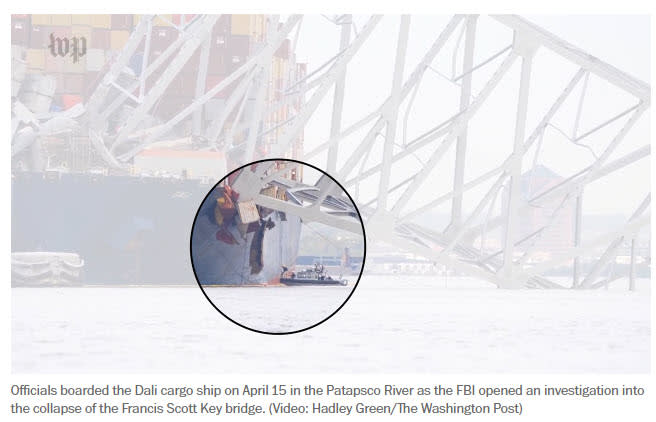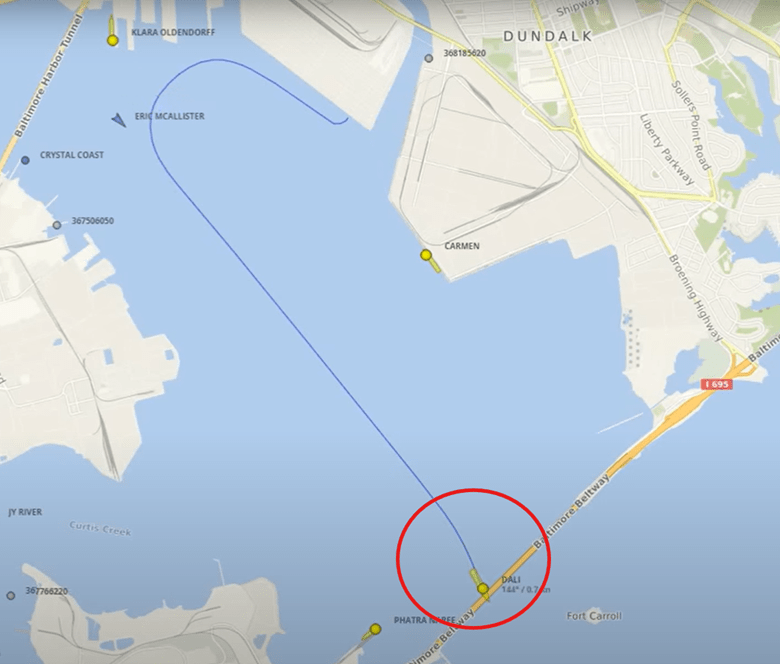Navigation
Install the app
How to install the app on iOS
Follow along with the video below to see how to install our site as a web app on your home screen.
Note: This feature may not be available in some browsers.
More options
Style variation
-
Congratulations MintJulep on being selected by the Eng-Tips community for having the most helpful posts in the forums last week. Way to Go!
You are using an out of date browser. It may not display this or other websites correctly.
You should upgrade or use an alternative browser.
You should upgrade or use an alternative browser.
Baltimore Bridge collapse after ship collision 125
- Thread starter Tomfh
- Start date
- Status
- Not open for further replies.
Not a marine eng so dunno.
I noticed them/they moving cans off the front but that is likely on an as necessary basis. I've just come to believe that it will be refloated intact with most of the load in place. Does anyone have any insight regarding the cargo and Tug's comment?
I noticed them/they moving cans off the front but that is likely on an as necessary basis. I've just come to believe that it will be refloated intact with most of the load in place. Does anyone have any insight regarding the cargo and Tug's comment?
Crash energy management requires conjuring many fantasies making many assumptions about the collision. Real collisions rarely obey the fantasy assumptions.
In broad terms, the goal of CEM is to share the energy dissipation between the objects involved in the collision - in this case a ship and a "dolphin".
But a dolphin that would deform to absorb its share of a collision from a ginormous ship like the Dali would be effectively an immovable object for a smaller ship, which would cause the smaller ship to take the full force of the impact.
Conceptually, you could get around this challenge with many small dolphins. A small ship would engage with only a few, while larger ships engage with many. Then is becomes a problem of space.
CEM works reasonably well when everyone is working to the samefantasy standard. For example automobiles, where (in the US at least) there are defined sets of collision cases to design for.
In broad terms, the goal of CEM is to share the energy dissipation between the objects involved in the collision - in this case a ship and a "dolphin".
But a dolphin that would deform to absorb its share of a collision from a ginormous ship like the Dali would be effectively an immovable object for a smaller ship, which would cause the smaller ship to take the full force of the impact.
Conceptually, you could get around this challenge with many small dolphins. A small ship would engage with only a few, while larger ships engage with many. Then is becomes a problem of space.
CEM works reasonably well when everyone is working to the same
where (in the US at least) there are defined sets of collision cases to design for.
That's mostly true, IIHS testing resulted in adding design cases to auto design; the offset collision case comes to mind. The makers complained that it wasn't part of the federal test suite, but eventually added it and tooted their horns about having it.
TTFN (ta ta for now)
I can do absolutely anything. I'm an expert! faq731-376 forum1529 Entire Forum list
Retiredat46
Member
I snagged this picture off a news broadcast last week. It's an incredible mess they're dealing with, and it looks like the bow was just abraded away in the collision. That big block of concrete must be part of the bridge support. I'm surprised to see such a clean break on something so massive.


LittleInch
Petroleum
This photo from earlier makes it pretty clear those towers were hollow section reinforced concrete. So OK in compression but not really very strong when hit by a ship.

Remember - More details = better answers
Also: If you get a response it's polite to respond to it.

Remember - More details = better answers
Also: If you get a response it's polite to respond to it.
NOLAscience
Structural
MintJulep said:Conceptually, you could get around this challenge with many small dolphins. A small ship would engage with only a few, while larger ships engage with many. Then is becomes a problem of space.
As the ship channel is linear for about 12 miles (maybe 8 miles upstream in the harbor and 4 miles downstream on the ocean side), it seems that a line of many smaller dolphins could have been placed on the approach to the bridge supports. I know this means that ships have to go upstream and make a U-turn to enter the ship channel, but in this case, the dolphins seem to have been necessary.
NOLAscience
Structural
Baltimore Harbor and Channels 50-Foot Project, Maryland and Virginia
Fact Sheet
1 Feb 2015
Link
They're all about deepening the harbor for bigger and bigger ships, but not about protecting the bridge...
Fact Sheet
1 Feb 2015
Link
They're all about deepening the harbor for bigger and bigger ships, but not about protecting the bridge...
Retiredat46
Member
I wonder if the engineers will consider the effects of climate change when designing the replacement bridge. The latest sea level rise map shows the harbor having serious water issues by 2050. And NOAA says their map may be a little low. Rebuilding the bridge will take a few years (the original took about 5 years). And most of the roadway to and from the bridge will have water issues before 2050. It doesn't make much sense to design a bridge to last a hundred years when you'll start having trouble getting to it only twenty years after it opens. The same thing applies to bridge protection structures which will become less effective as the water level rises.
-
2
- #311
Alistair_Heaton
Mechanical
I don't think it is, they have already changed the codes this side of the pond to future proof against various predicted environment changes.
NOLAscience
Structural
FBI opens criminal probe into Francis Scott Key Bridge collapse in Baltimore
Story by Michael Kosnar and Ken Dilanian and Marlene Lenthang
Story by Michael Kosnar and Ken Dilanian and Marlene Lenthang
-
2
- #315
RoopinderTara
Mechanical

The FBI boarded MV Dali this morning, opening an investigation and preempting the NTSB and Coast Guard investigations, according the the Washington Post. The FBI is being tightlipped about what they are looking for but the Post imagines it to be about the crew setting sail knowing there were system problem aboard.
Roopinder Tara
Director of Content
ENGINEERING.com
RoopinderTara
Mechanical
I'm trying to plot the precise path on CAD of the MV Dali in her last mile of so to show it be consistent with the path of a ship with a rudder locked in position, possibly a hard left. I can get approximates location from videos online but does anybody have the AIS data the videos were based on? Or know where I can get the data? AIS data has precise location and heading information that would be helpful in proving or disproving the rudder-locked-position theory.


Roopinder Tara
Director of Content
ENGINEERING.com


Roopinder Tara
Director of Content
ENGINEERING.com
Murph 9000
Computer
I'd be careful about how you interpret the AIS data. It's good for giving other vessels a general overview of the traffic around them, which is its primary purpose; but is not designed or intended to be a high resolution and rapidly updating trace of a vessel's movements.
There are many factors which would have influenced the ship's heading after power loss. If the main engine was not powering ahead, the rudder would have quite limited influence on the ship's heading; and if it was powering astern while the ship was moving ahead, possibly no influence on the heading. The rudder is only properly effective when the ship is moving and powering ahead; it effectively redirects the ahead thrust of the propeller. The combination of current in the main channel, current from the side channel, and wind could explain the change in heading. The final stages of the turn could also, possibly, be the starboard bow grounding on the shallower water between the main channel and the bridge pier.
If they did go hard astern when the lights first came back on, that could account for the turn after that moment. This was my initial thought from the large cloud of dense black smoke and heading change, but I'm now more 50:50 on it.
Trying to resolve all of the above into a reliable analysis of the rudder position seems like a very tall order to me.
There are many factors which would have influenced the ship's heading after power loss. If the main engine was not powering ahead, the rudder would have quite limited influence on the ship's heading; and if it was powering astern while the ship was moving ahead, possibly no influence on the heading. The rudder is only properly effective when the ship is moving and powering ahead; it effectively redirects the ahead thrust of the propeller. The combination of current in the main channel, current from the side channel, and wind could explain the change in heading. The final stages of the turn could also, possibly, be the starboard bow grounding on the shallower water between the main channel and the bridge pier.
If they did go hard astern when the lights first came back on, that could account for the turn after that moment. This was my initial thought from the large cloud of dense black smoke and heading change, but I'm now more 50:50 on it.
Trying to resolve all of the above into a reliable analysis of the rudder position seems like a very tall order to me.
- Status
- Not open for further replies.
Similar threads
- Replies
- 0
- Views
- 3K
- Replies
- 13
- Views
- 13K
- Question
- Replies
- 39
- Views
- 21K
- Replies
- 17
- Views
- 11K
- Replies
- 25
- Views
- 25K
